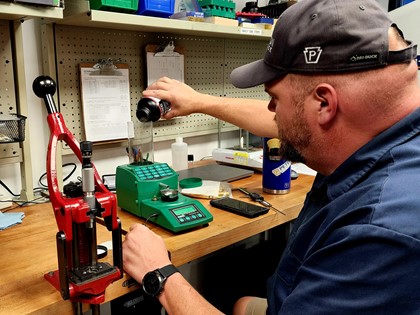Handloading for Increased Accuracy
 Let’s face it, guns and ammunition are awesome. What red-blooded American doesn’t enjoy the smell of gun powder or watching their bullet impact the target. I don’t care if you’re hunting Dall sheep in the Mackenzie Mountains, competing at the GAP Grind in Tennessee, or plinking soda cans in the backyard, America has a love affair with guns. However, as noted author and outdoorsman, Townsend Whelen, once said, “Only accurate rifles are interesting”.
Let’s face it, guns and ammunition are awesome. What red-blooded American doesn’t enjoy the smell of gun powder or watching their bullet impact the target. I don’t care if you’re hunting Dall sheep in the Mackenzie Mountains, competing at the GAP Grind in Tennessee, or plinking soda cans in the backyard, America has a love affair with guns. However, as noted author and outdoorsman, Townsend Whelen, once said, “Only accurate rifles are interesting”.
He was right. I don’t know of any shooter who wants a gun that can’t hit its target. I want to take it a step further and say that, only precise ammunition is interesting. Just like no one wants an inaccurate rifle, no one wants to buy or use ammo that can’t hit what it’s aimed at. Here’s the rub, we’ve gotten away from accurate, precise rounds and moved to mass-produced cartridges. Granted, the recent lack of components and raw materials definitely factors into this (right now we sometimes find ourselves in a take what we can get situation), but even before the current shortage there were glimpses of this behavior.
My friends who are Precision Rifle Series (PRS) shooters and I like giving each other a hard time. I jokingly tell them I shoot for real (hunting), not for steel. They, in turn, poke fun at me by reciting the old adage, “If I can hit a pie plate at a hundred yards I can kill a deer!”. While I cannot bring myself to admit this to any of my buddies, the sad truth is, there are a lot of hunters out there who have this mentality. I like to refer to this type of hunter as a Fudd, named after Elmer himself. I don’t say this to put anyone down, or because I’m an elitist or Boujie hunter. But I do feel if you are not concerned about being as precise as possible while hunting then you’re not doing right by the animals you’re chasing or being a good representative of the hunting community. This opinion may make me unpopular in certain circles, but it needs said.
To be honest, with all the advancements in rifles, bullet design, components, and manufacturing over the last few decades, there’s no reason hunters can’t hold sub-MOA groups at distance. One of the easiest steps any hunter can take to become more precise is to handload their own rounds.
There is an art to handloading, but it’s not magic. With a little practice and a willingness to test different loads, anyone can produce a round more accurate and precise than one purchased off a store shelf. The reason for this is simple, any commercially produced ammo is intentionally designed to work in a broad range of guns. Ammo that is built for, tested in, and based on a Sako rifle may not shoot well when fired from a Browning. So commercial ammunition has to have broad appeal. Handloading is the exact opposite.
When handloading, you are building a load for your specific rifle. You have the ability to adjust and experiment with every single component and spec. You can use different weights and makes of projectiles based on your intended use. Powders can be swapped, seating depths can be adjusted, or any number of other variables can be changed. The point is, handloading allows you to be as precise as you want to be and develop a load that is truly yours.
For example, when I am preparing for a hunt, I will do different load work ups based on what game I’m going after. I will try different bullets, different powders, and even different primers until I find the right combination that gives me the results I want. While doing my testing I will look for good velocities, low standard deviations, and small extreme spreads. Once I find a load that meets these criteria I go to the range and shoot for accuracy. I do most of my accuracy testing at 100 and 300 yards. If I get good results, by good I mean sub-MOA, then I will start shooting out to 1000 yards to verify my load. If this satisfies my requirements, I will load a larger amount of cartridges to use on my hunt.
Another aspect of handloading that I like is, it puts the guarantee of quality on me. If there’s something wrong with the cartridge it’s my fault. Either I wasn’t paying attention or didn’t do something correctly. With factory ammo you have no idea if the person or machine loading it had a malfunction or a bad day. I was on a moose hunt in British Columbia a few years ago and had a dud cartridge in my rifle when I took my shot. Luckily, I was able to eject it, get another round in the chamber, and take my shot. Afterwards I checked that box of ammo and three of the 20 cartridges would not fire. Ever since then I’ve only used rounds I loaded myself.
There are a lot of different reasons to handload, but for me the benefit of increased quality and dependability are what convinced me it was the way to go. I realize that not everyone has the time to do it and components can be difficult to procure, however, if putting in the effort to makes you even just a little more accurate, isn’t it worth it? Until next time, good luck and happy hunting.